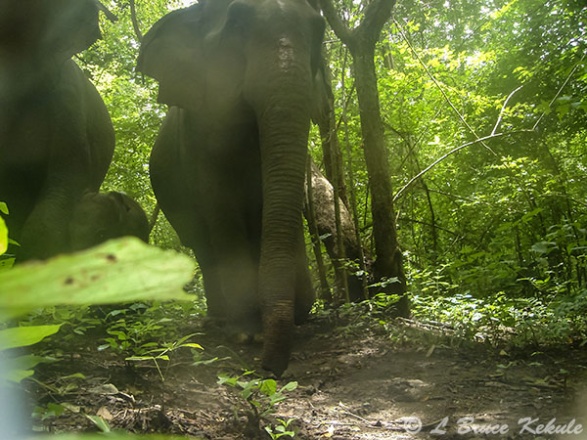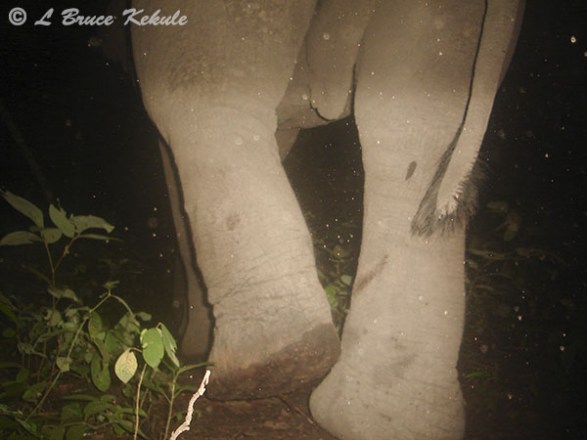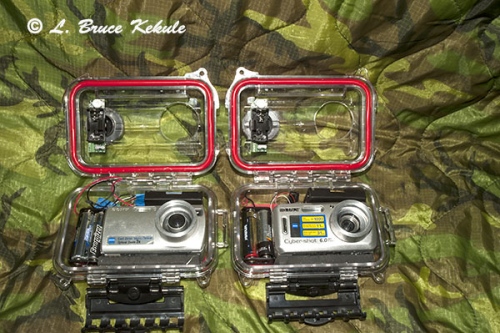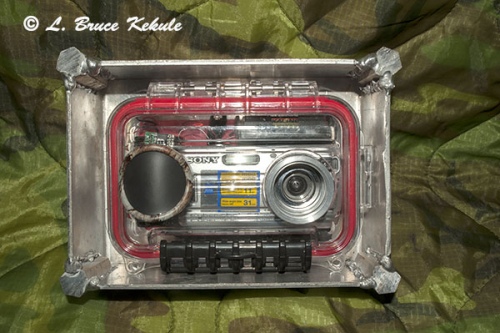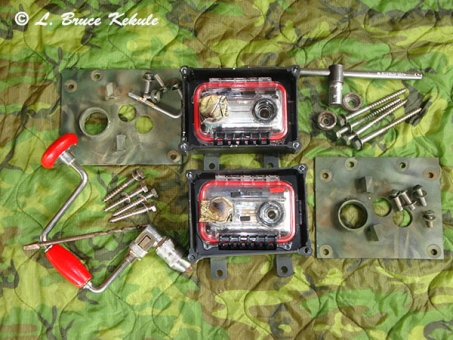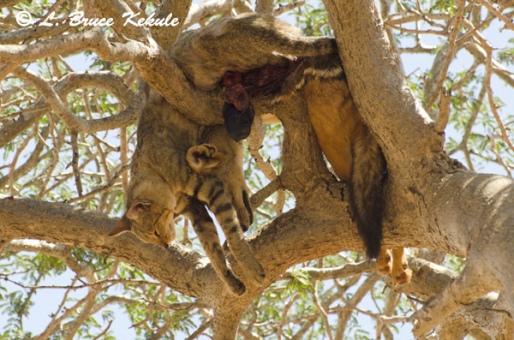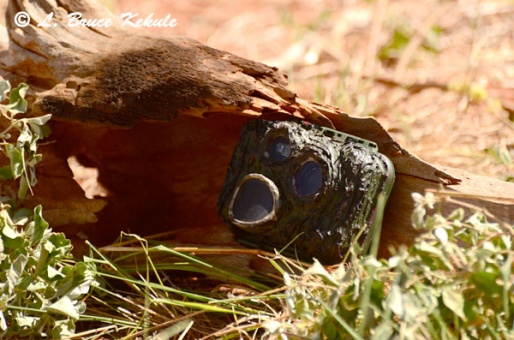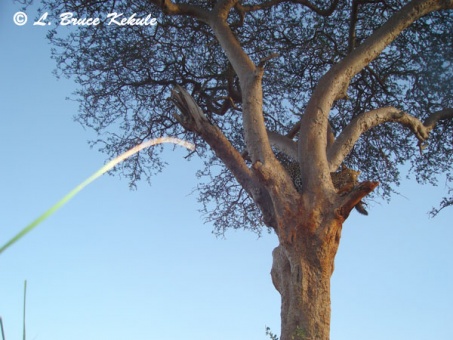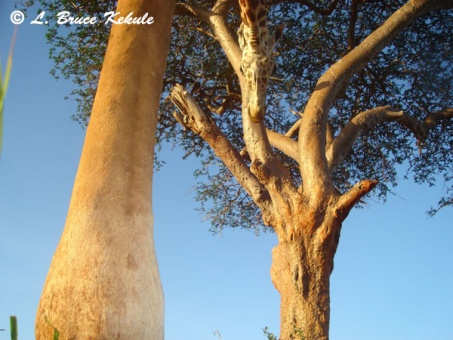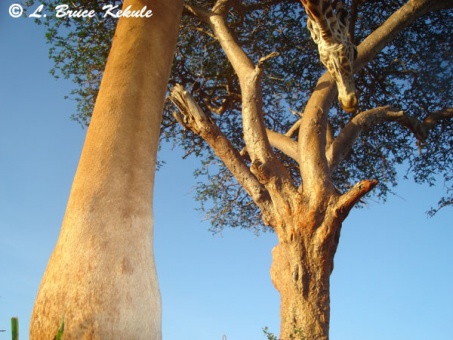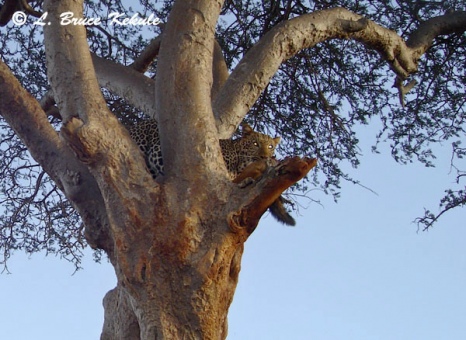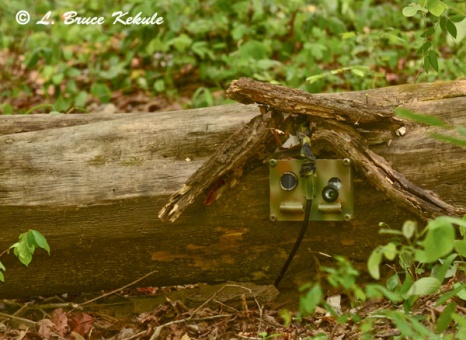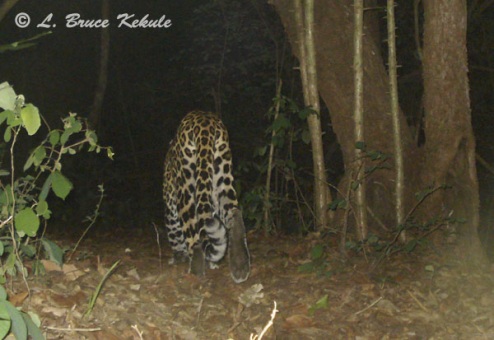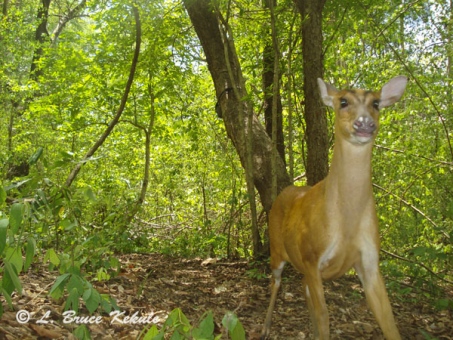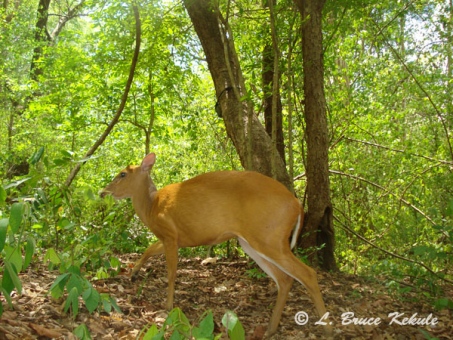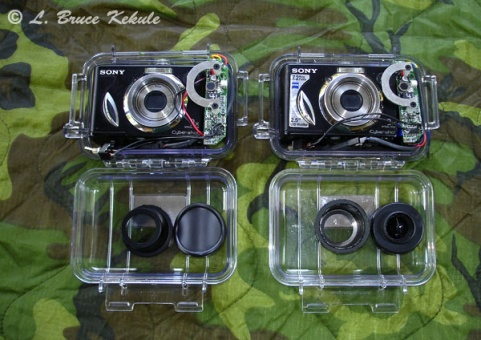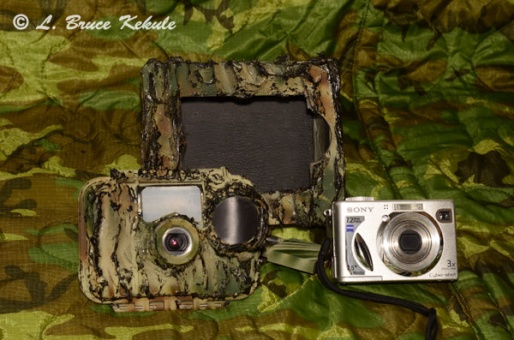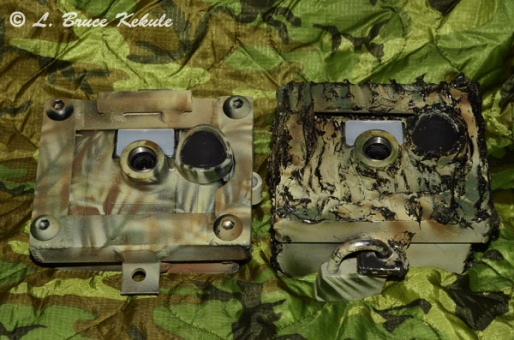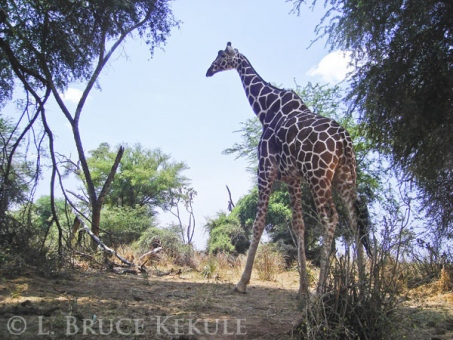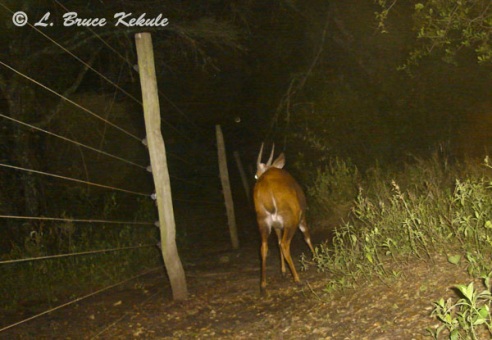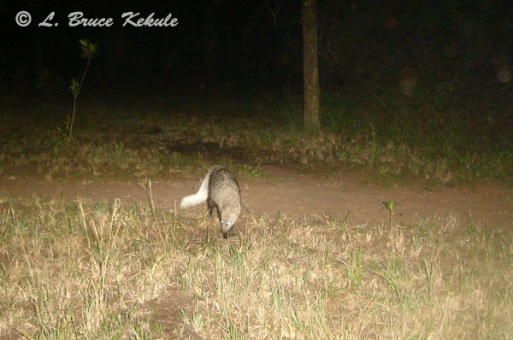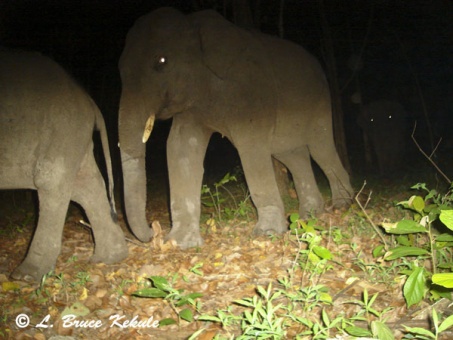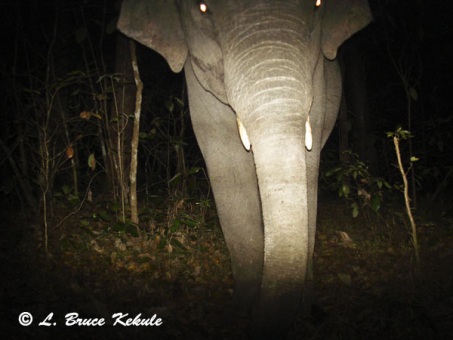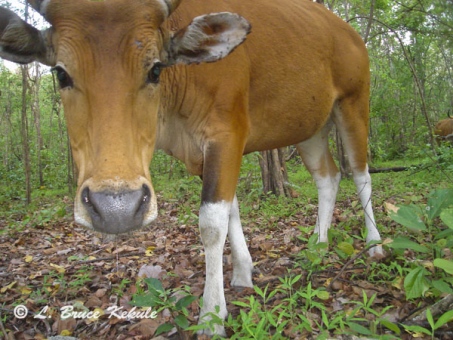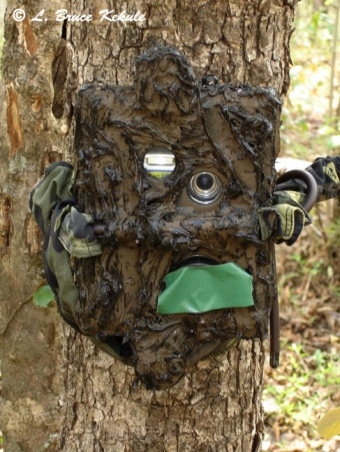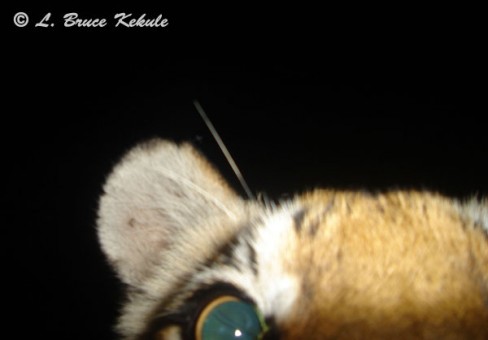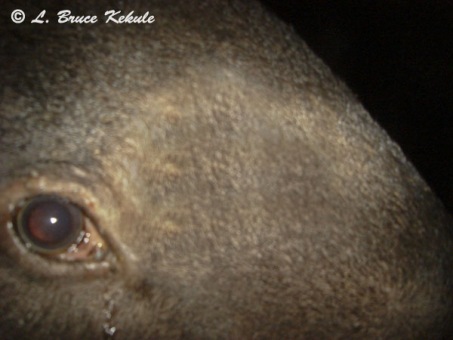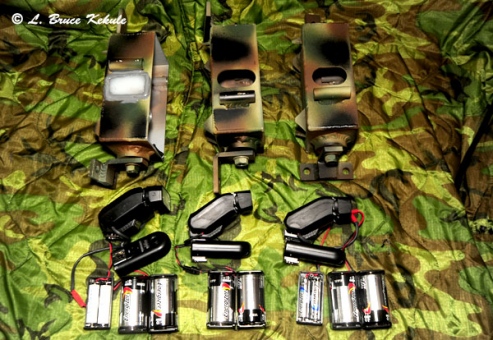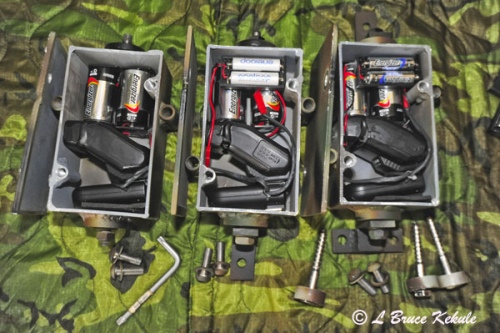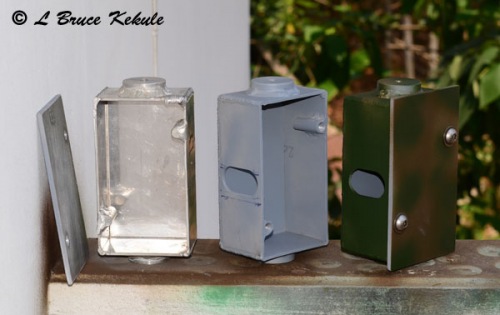Posts Tagged ‘homebrew camera trap’
A wild elephant’s foot…!
All images by a Sony S600/S40 camera trap
Wild Asian elephant herd checking out my camera trap
The toughest test of a camera trap in Thailand’s forest is being attacked by the awesome power of a wildlife elephant. These huge beast are very inquisitive and will check-out anything that catches their eye. Camera traps are of special interest and depending on how tight the cam is on the tree, these giants will try to rip it off. The following sequence was captured last month.
Mother elephant and baby
Elephant’s rear end
Female elephant showing tushes
Elephant’s muddy foot
Another ‘mud paw’
They tried in vain to get my cam off but it was so low, they could not get any leverage so they just used their muddy ‘paws’ but failed. However, the lens and sensor were covered in mud after this. The last few shots show what an elephant’s foot looks like…!
Special interest:
This shot of a very old, old banteng bull with a damaged pair of testicles was earlier on the same setup before the elephants. No telling what happened to this poor guy. He was probably evading a predator and scratched em’ on a stick while bolting through the forest. There are big tigers here that go after the old bulls…!
This bull is very old judging from the hang on the dang….!
Indochinese tiger camera trapped in Huai Kha Khaeng
An Indochinese tiger with a radio collar around its neck.
A big cat camera trapped in Huai Kha Khaeng Wildlife Sanctuary, Western Thailand using my BFOutdoors’ camera trap with a P43/1040/two ‘C’ cell externals.
There is an on-going scientific survey following some eight tigers in the sanctuary gathering data on their range and behavior. It has been proven in India that tigers with collars do not breed well and hence, I’m not too convinced the program is viable at this location. Also, the data on tiger numbers is not shared with the general scientific community and kept highly secret by a few individuals and an international conservation NGO. It is hoped that one day these collars (which must be very uncomfortable) will be removed to allow these magnificent cats to carry out their lives naturally.
More LBK ‘Clear-view’ camera traps
Sony S600-S40/Plano 1449/SSII/4 AA externals homebrew cams
This year’s competition in Camtrapper.com was great and really a challenge to make a winning shot. I was surprised to see my ‘Needle in the Haystack’ leopard actually place and when all the winners took their prizes according to their rating, I was left with a Sony S40. I felt extremely lucky to win this cam hacked by Joe 12-Ringer and waited patiently to get my prize, as I have never have had one and wanted to use it for a homebrew.
Sony S40 and S600, Plano 1449 case, Snapshotsniper II boards and 4 AA externals
While I was in the States recently, I visited Dick’s Sporting Goods store in Albany, NY. It took me awhile, but I eventually found some Plano cases Model 1449 that looked perfect for camera traps. I liked the clamp that looked strong, and the seal was nice and soft for a watertight seal similar to rope seal. The case looked plenty strong and the internal dimensions would allow two twin-AA externals. With Gary’s SSII, I can get everything in with room to spare. A snorkel was machined from 3/16” thick aluminum tubing.
Ready for final assembly
While I was in the U.S., I had several cameras working in the forest here in my usual locations including two Sony S600s/1020s/SSIs with security tubes. These had elephant proof boxes with Python locking cables and two 3/8” Stainless lag bolts at the bottom of the box but one was in a very low down set-up. An elephant found it and decided to give it a whirl. The giant managed to bend the bolts 90 degrees and finally dislodged it from the horizontal tree and stepped on the cam breaking the glass. The 5/16” ‘Python Locking Cable’ however survived the ordeal.
S600 unit in a ‘elephant proof’ box
Fortunately, the S600 and board is still working so I decided to build another cam using the S600 and the 1449 (same set-up as the S40 above). Machining the cases for the snorkel and the HPWA is pretty straightforward. I have begun making the ‘elephant proof boxes’ which need further work but will get these done just before my next trip into the forest. I will up-date this post with pictures when these are done.
Machining S40 faceplate
Finished S600 faceplate painted with primer
Camouflage painting both cams
Finished S600/S40 cams ready for the field
Both units setup on a fallen tree on a game trail
African leopard camera trapped in Tsavo East NP, Kenya
‘A Needle in a Haystack’: A Sony S600 catches a leopard eating prey
Sometimes, things happen that are unexplainable and spooky. That goes for the following story. I have just returned from Africa and while on safari, was able to slip two camera traps in the bush (a Sony S600 and W7) at several locations. But the weirdest setup was in Tsavo East National Park in Southern Kenya not far from the infamous ‘Man-eaters of Tsavo’ site.
To get a perspective of how huge this place really is (Tsavo – East and West) is the largest national park in the world at more than 43,000 square kilometers (the size of Wales, Israel and New Jersey). Finding a leopard is like finding the proverbial ‘needle in a haystack’.
Leopard’s prey: A wild cat and a black-backed jackal
One morning as my companion, driver and guide Patrick Mjoroge and I were out on a game drive (as they are known), he spotted two leopard kills hanging in a tree by the side of the road. We stopped and saw a wild cat wedged on top of a jackal in the branches, and both ‘dead as door nails’.
Sony S600/1010/SSII camera trap on the ground at the leopard tree
The big cat for a later meal stashed these two small predators and so we waited for a while but in vain. Then it dawned on me: why not just throw my S600/SSII/1010 on the ground in a hollow piece of dead wood pointed up at the big tree. It was worth a shot! Later that day, we drove by several times but the leopard was no-where to be seen.
A full-size image of the African leopard in a tree eating its prey
The carrion was still there so I decided to let it soak overnight until the next morning thinking the carnivore might come at night to eat its prize. I took a few shots of the hanging dead and the set-up, and we departed quickly not wanting to hang around obviously. The leopard on the ground is extremely fast and I was not sure how close it might be waiting, and we might just turn into dinner.
Bright and early the next morning, we drove directly to the tree and found the two kills gone. A small tree branch had fallen right in front of the cam and I thought I had missed the cat for sure. As I scanned through the images, I could see nothing but a large leg in several frames. A giraffe had almost stepped on the cam before we arrived and I could see its head up close to where the kills had been. I was a bit disappointed.
Giraffe at the leopard’s tree
Then, I decided to scroll through again and noticed one frame was darker just before the giraffe shots. I zoomed in and almost jumped out of the truck. Low and behold, I saw spots in the crotch of the tree and then saw the leopard’s head looking down towards the cam with the jackal in its mouth. The big cat had visited late in the afternoon and the background sky was nice and blue. I was speechless for a few moments until I could talk again.
Giraffe very close to the S600
I began jumping up and down in the back until Patrick told me to calm down. I showed him the shot and we both began celebrating this remarkable camera trap event. It definitely was worth several rounds of drinks or ‘sundowners’ as they are known in Africa later at the bar in the tented-camp.
Leopard close-up eating the jackal
Weird is an under-statement and the ‘spirits of the wild’ had answered my wishes. I have cropped and enhanced the leopard shot so it can be seen quite clearly. Remarkable is all I can say and the little S600 did a herculean job of catching a ghost!
More set-ups to follow: The S600 also traps hyena, baboon, impala, waterbuck, and the W7 catches elephant plus a bushbaby in a hotel bar getting the largest and one of the smallest mammals found in Africa. It was an amazing trip to the ‘Dark Continent’ as it was known in the old days, and hope everyone enjoys these camera trap photographs.
Huai Kha Khaeng ongoing camera trap saga
New camera trap gets a leopard and tiger first time out
Sony W55 in Otter 2000 case with a Snapshotsniper SSII board and 3 AA externals
The feeling of accomplishment is the best part of building a ‘homebrew’ trail camera and then sharing the photos with others. I am extremely lucky to be working in a place that is one of the top tiger reserves in the world, and is extremely productive for camera trapping. It is not only the tigers, but also other predators like leopard, wild dog and jackal, and their prey species such as deer, pig and wild cattle that makes Huai Kha Khaeng Wildlife Sanctuary truly special.
A leopard caught by the Sony W55 camera trap
When I first built this unit, I had one fallen tree across a trail in mind and it proved to be the right choice. I designed the cam to slip the 10mm ‘Python’ locking cable around the horizontal log. One of the first animals to jump over was a mature male leopard several nights after the setup. This frame filling shot is what I was hoping for.
Leopard caught again as it went down the trail
Several nights later, a tiger went over and the W55 caught its rear end as it disappeared down the trail. A female muntjac (barking deer) was also caught. This was after only a 15-day soak and shows the tremendous biodiversity of this amazing place. This unit definitely worked as designed: to scout a game trail with a low-down set-up.
Tiger caught going down game trail several nights later
The next order of business now is to build a Nikon ML-3 ‘active-infrared’ controlled SLR Nikon F5 film camera using Fuji Provia 400 ISO slide film, and a Nikon D2x DSLR and both can fire five shots a second in ‘continuous mode’ with several wireless SB600s or SB28s. These two cameras are my old prime camera bodies that I have kept over the years (they were really expensive), and I have resurrected them for this project. The Nikon D2x is now in the Nikon shop for an overhaul but will be finished real soon.
Female muntjac (barking deer) caught by the camera trap
My main objective is to catch the cats making the jump. I will eventually be installing both units close together on either side of this log about a meter or so away from the trail. The sensors need to be slightly angled away so as to activate them a bit early. Both cameras will be using an 18-35mm wide-angle lens (the zoom setting of the lens will be adjusted when installed) and that should help to catch these quick-acting animals. The units have to be precise and fast, and fire off a good string of shots with several flashes.
Muntjac spooked by the camera’s flash
The only negative aspect with active infrared at night; the first shot will not trip the flash but follow up shots will be OK. But I can also hard wire a flash for each cam with a sync-cable in conjunction with the wireless flashes and that should be enough. I will also experiment with a ‘passive infrared’ system that can wake-up the flashes in time for the shot. However, this is a hit and miss situation whereas active infrared is usually spot on and will trip immediately after the beam is broken.
The system will be modular so sensors and camera are separate, and they will be ‘plug and play’ units. That’s the plan anyway for this absolutely amazing wildlife game trail. I have all the parts ready; just finding time to put it all together is the next trick.
Got a very busy schedule with a trip to Africa and the States for the next couple of months. But I will be getting the SLR and DSLR camera traps up and running shortly after getting back to Thailand, and of course will post the builds. Most important: they have to be ‘elephant proof’ but I have that covered as usual.
Posted from Tsavo National Park, southern Kenya, Africa
Two camera traps for Africa
LBK ‘Clear-View’ trail camera project: Twin W7/1010/SSIs
Sony W7s in Pelican 1010 cases with Snapshotsniper SSI boards
In 2008 when I first began building digital trail cams, I used several different models of Sony, Nikon and Canon cameras but found the Sony W7 to be one of the best producing very good quality photographs, both day and night, with its Carl Zeiss lens set to ISO 400 in ‘program’ mode. I actually use a W7 for general photography while in the field and have come to like this model even though it’s a bit large for a digital compact compared to newer models.
W7/1010/SSI components ready for building
The W7s are robust cameras that use two AAs and are fairly quick for all-round use. The only drawback; they are tough to hack and a steady hand, good eyes and nerves of steel is needed to modify these as the connections are tiny..! Check out Camtrapper.com and Buckshot164’s video tutorial on the W5-7, or the W1 for that matter (similar camera).
By using the Pelican 1010, they are truly ‘pocket size’. I normally use two ‘Energizer Lithium’ batteries that can usually last a month or more. I bought 8 W7s and built camera traps around six of them but kept these two for a special job one day.
W7/1010/SSI cam #1
I sourced the clear Pelican cases and managed to get some of Gary’s last SnapShotSniper ‘Simple Sniper’ boards before he discontinued them. I also ordered the metal sensor mount for easier installation with epoxy. By laying the camera and the 9-volt battery in the deep end of the case and the sensor in the shallow end, everything just fits.
W7/1010/SSI cam #2
The build is straight forward, and no hole is cut in the case for the flash allowing the camera to shoot straight through. A lens snorkel and HPWA is used and there are no externals. I have tested most of the cameras in this ‘clear view’ series and the power of the flash is not cut down by the case.
In fact on these builds as an experiment, I’ve installed a flash diffuser (cut from a Nikon SB26 flash diffuser) to cut back on harsh light sometimes caused by the factory flash. This idea came from an Olympus ‘dive housing’ for their U-700 digital compact shown here. My main objective with camera trapping is close frame filling shots that really show wildlife and the diffuser just softens the flash.
Olympus U-700 digital camera in an Olympus dive housing with a flash diffuser
A couple of aluminum boxes protect the W7s/1010s and a ‘Python’ 5/16” locking cable is used plus small ‘shark teeth’ are welded on the back to lock the cams in place on a tree. Holes are drilled to accommodate two lag bolts but these will not be used where I’m going, but later when I deploy these cams in the field here in Thailand. I have made-up one with 3D camouflage pattern and the other with 4-color camouflage paint job using fern leaves.
Completed trail cams ready for the field
I have built these two for my yearly African photographic trip that is coming up on May the 1st for two weeks. I will be going to Kenya once again, but this time will be visiting the great Amboseli (close to Mount Kilimanjaro) and Tsavo (East and West) national parks plus Shimba Hills Wildlife Sanctuary (especially after sable) and finally close out the safari at Nairobi National Park.
I hope to slip them in depending on local restrictions and laws, plus available wildlife and forests in the hotels and resorts where I will be staying on the fringes of the protected areas. In most reserves in Kenya, one is not allowed to leave the safari vehicle at any time or place other than in the hotels, and heavy fines can be incurred by the driver/guide (more than a $1,000 US dollars) if they are caught. It seems unjust but some people have already been maimed and even killed by this reckless behavior.
Detail of the drilled and taped box
In 2010, I slipped a trail cam in the bush and got a beautiful shot of a giraffe in Samburu National Park and then in 2011, got several shots of the rare bushbuck (both male and female), an African mongoose and a large-spotted genet plus a night patrol ranger with a .458 Winchester M70 express rifle at Siana Springs Tent Lodge near the Masai Mara Game Reserve. It was a neat experience.
Sony W7s and Sony S600 trail cams: ‘Python’ locking cable and camouflage sleeves.
These two Sony W7s and another Sony S600 are some of my smallest trail cams and just right to take with me while flying abroad. Being little, they are easily carried in my baggage and set-up will be quick. I will post any pictures at a later date.
Camera trapping in Africa
Capturing wildlife by camera trap while out on photographic safari
Reticulated giraffe in Samburu National Reserve: A lucky capture..!
In September 2010, I went on a photographic safari to Kenya’s protected areas including the Masai Mara National Reserve during the annual wildlife crossings at the Mara River, and then on to Lake Nakuru National Park and Samburu National Reserve. It was difficult to set trail cameras as the laws are very strict about leaving the vehicle while out on safari.
Finally, on the next to the last day, I got a quick chance to slip a camera in the bush off a dirt track by the river in Samburu. After three hours, my guide and driver said we had to retrieve the cam. Low and behold, a giraffe had passed the Sony P43/Bigfoot/1040/’C’ externals. It was a fluke and the shot shown here was the best of two. The lowdown set really enhances this very tall even-toed ungulate.
A rare male bushbuck during late afternoon in Siana Springs Tented Camp near the Masai Mara National Reserve
Then in August 2011, I was back in Kenya for another 12-day trip and the first three days was spent at Siana Springs Tented Camp next to the great Masai Mara reserve. The amazing thing about this place was the bushbuck, a very rare antelope, is found on the grounds. I asked for permission and set out three traps. After a couple of nights, a Sony S600/1020/SS1 trapped a ‘male bushbuck’, an African mongoose and a large-spotted genet. On another cam, I got a female bushbuck.
Male bushbuck camera trapped at night on the grounds of Siana Springs
On my older P43/Bigfoot/1040 with ‘C’ cell externals, I trapped a night patrol ranger as he passed by showing his boots, long coat and rifle….amazingly, it is a pre-64 Winchester Model 70 Supergrade in .458 Magnum ‘African’ model with express sights and a beautiful select walnut stock. What a rifle to have out on night patrol?
Night patrol ranger with a .458 Winchester M70 ‘African’ model. A rare firearm left over from the old days of hunting safaris
Some rich American hunter left this rifle with the old boy who was previously a tracker and guide for safari hunters in days gone by. I use to be a gunsmith and built many rifles from old shot-out Model 70s and Mauser 98s. I felt a bit of nostalgia, as this was my favorite caliber and I used a .458 Model 70 when I hunted with a gun here in Thailand but that was 25 years ago, and is another story. I’m still a hunter at heart, just switched from Winchester to Nikon, Minolta, Canon and Sony.
Female bushbuck along a trail on the grounds at Siana Springs
I’m off to Kenya once again on May 1st armed with my big Nikon D3s and a new Nikon 200-400 VR II telephoto lens. I will also be taking three camera traps and hopefully I will be able to set a few cams here and there as I know some tented camps usually have wildlife running around the grounds…plus the guards…..hmmmm!
White-tailed mongoose, a common carnivore
Large-spotted genet, another common predator
These three cams are the ones I’m taking with me to Kenya. The two in the back are Sony W7s in Pelican 1010 cases with Snapshotsniper SS1 control boards, and one in front is a Sony S600 in a Pelican 1010 with a SS1 control board. These cams are small and light, and easily packed in my luggage. I hope I can set them up…..that is the big question??
Camera traps ready for Africa
Huai Kha Khaeng: A camera trap saga
Thailand’s amazing forest with some beautiful, elusive and rare Asian creatures
Huai Kha Khaeng Wildlife Sanctuary is situated in central western Thailand, and is a World Heritage Site. It is the top protected area in the Kingdom. In January 2012, I began a camera trap program to determine the status of wildlife found here. In just a short two months, all the large mammals including elephant, gaur, banteng, tapir, tiger, leopard and many others have been caught by ‘homebrew’ digital camera traps set at various mineral deposits, water holes and game trails situated in the interior of the sanctuary. I have ten trail cams working through till March 31st, 2012. These are the best series. The following photos shows this amazing biodiversity, and this place is truly worthy of its ‘World Heritage Site’ status.
Set-up Number 1: A S600/1010/SSI was set above a water hole close to a ranger station. This cam turned out the most wildlife photos over a two month period. This mineral deposit and waterhole is visited daily by many animals and is one of the best in the sanctuary.
A Sony S600/Pelican 1010/SSI in an ‘Elephant proof ‘ box with a ‘Python’ locking cable
Mature female tiger
Tiger follow-up shot
Young tusker elephant in a herd
Tusker close-up
Tusker about-face
Mature gaur bull
Mature banteng bull
Younger banteng bulls
Mature banteng cow
Banteng cow close-up
Macaque monkey
Camera trapper
Set-up Number 2: Another S600/1010/SSI was set close to the ranger station and a bag of large rotten fish heads was strung up to prevent being taken by a scavenger like a water monitor. Amazingly, a leopard and a big wild boar, both scavengers, came to the bait. The bag can be seen in the boar picture. Boy did it smell..!
S600/1010/SSI in ‘elephant proof’ box with python locking cable.
Leopard male in the stream attracted by the ‘fish head’ bait.
Wild boar hoping for some carrion.
A crab-eating mongoose in the stream after the bait had been cut down.
Set-up Number 3: An old Sony S600/1040/BFOutdoors/2 ‘C’ cell externals in an ‘elephant proof’ box and ‘Python’ locking cable with 3D camouflage was used to catch this tiger mother and her cub (also caught by Bushnell Trophy Cam video twenty meters away). Other shots collected from this cam were deer at night not included here.
Sony S600 in a Pelican 1040 and BFOutdoors board with 2 ‘C’ cell externals
Tiger mother caught close to Subkaow mineral deposit and water hole
‘Eye of a tiger’ as this young cub has a chew on the cam…remarkable shot…!
Set-up Number 4: An older S600 with a Yeticam board in a 2nd generation LBK aluminum boxed cam plus tools for installation. Tiger, tapir and a sambar stag came along this trail about a day’s walk from the ranger station I stay at. This site will be covered by long-range cams with ‘C’ and ‘D’ cell externals for a three-four month period during the rainy season.
Old 2nd generation LBK trail cam in an ‘elephant proof’
housing firmly bolted to a tree with a ‘Python cable and 2 lag bolts.
Rear-end of a tiger along a game trail
Asian tapir at night
Tapir up-close and checking out the cam
‘Eye of a tapir’….not as dramatic as a tiger’s eye..but OK for government work..!
A mature sambar stag, Thailand’s largest cervid
Note: I still have more then ten trail cams working here at the moment including my new Canon DSLR 400D with three wireless flashes, and two of my new W55s. I will also be setting up a homebrew video very soon. I surely will be posting many more camera trap photos of this truly wonderful and magical wildlife sanctuary in the near future.
Another pair of camera traps for the forest
LBK ‘Clear-View’ trail camera project: A pair of W55s but in different cases
W55s in a Pelican 1020 and Otter 2000 cases with SS II boards and 3 AAs
This project came forth with a need for trail cams that could last longer than my customary time of one month between card checks, battery and desiccant replacement. I wanted a camera trap to last at least two-three months without visiting the site. Digital cameras with ‘AA’ externals are the ticket. Over the rainy season would be a perfect setup from August to late October when the forests in Thailand are almost inaccessible due to swollen streams and rivers, and constant rain.
The Sony S600 digital camera has become increasingly difficult to find in Thailand and as of this post, none are available here. But the W50, 55 and 80s and other cameras in the ‘W’ series are easier to get being slightly newer. Actually, I believe the S600 has dried up because of the huge demand for them on eBay and the U.S. homebrew trail camera market.
Sony W55s in Pelican-Otter cases with SSIIs and AA externals
The second-hand camera shops in Bangkok are in ‘Chinatown’ and many have loads of different models to choose from. I picked up two W55s for a song, ordered a couple of Gary’s amazing little SSII boards, found a Pelican 1020 plus an Otter 2000, both in clear, and triple ‘AA’ battery packs for these two trail cams. Everything fit easily and I put them together in my shop.
I built two ‘elephant proof’ boxes from 3mm sheet aluminum and had my welder ‘Tig’ it all together. I now have incorporated half-inch alloy rods welded into the corners for a cleaner look, and then drilled and tapped for 10mm ‘power torque’ machine screws. Faceplates are machined for lens, flash and sensor from 3mm aluminum plate.
Back-end of ‘elephant proof’ boxes with Stainless 3″ lag bolts and washers
An aluminum tube is welded to the front for a Python 10mm locking cable and what I call ‘shark teeth’ are welded on the back to lock the cam in place on a tree. Two 3/8” x 3” stainless lag bolts secure it from inside the box and the backs are beefed up with ¼” plate where the bolts are (see photo). These units have proven to withstand the carnage handed out by wild elephants or poachers that sometimes can be a disaster waiting to happen.
There is a mineral lick more than a days walk from the ranger station I work out of in Huai Kha Khaeng Wildlife Sanctuary. I intend to set these two cameras plus a few others with externals at this location and let them work for a couple of months. This should be an interesting set and I will post photos and set-up when the time comes.
Conclusion:
Both units with an upgrade to 3 AA battery packs
Sony W55/Pelican 1020/Snapshotsniper SSII/3 AAs: This unit is for normal installation on a vertical tree housed in an aluminum box. A camouflage paint pattern was applied to the ‘elephant proof’ box. A ‘Python’ locking cable runs around the front and secures the unit in conjunction with two 3” stainless steel lag bolts and washers from inside the box.
Sony W55/Otter 2000/SSII/3 AAs: This unit being horizontal is better suited to fallen trees across game trails and other suitable locations that require special set-up. The ‘Python’ locking cable can be run both ways (horizontal or vertical) and hence is slightly more flexible in installation. Lag bolts lock the cam on a tree and the 10mm ‘power torque’ machine screws close up the faceplate making these tough to get into or off a tree.
Note: I originally installed two ‘C’ cells and when turned on, they began leaking in a couple of days but I saved the camera and board just in time and the camera’s finish got slightly blotchy. I also had to remove the lens door which now works very smoothly. I then removed the ‘C’ cells and replaced them with 3 AAs packs. The internal components are the same for both cams and alkaline AAs will be used for externals. I look forward to setting these two up sometime next week and leave them for two-three months, and of course, will post any photos at a later date.
A new DSLR camera trap
A Canon 400D trail camera with three Canon 270EX speedlights
This DSLR camera trap has been in the making for over a year but with many great opportunities now for tiger, leopard and other interesting wildlife photographs, I decided to finish it off.
DSLR Canon trail camera components
Canon 400D and ‘elephant proof’ aluminum box
Canon flash components
Close-up of wireless flash units
Machining flash boxes at my machine shop in Chiang Mai
Flash boxes in the raw, with a primer coat and camouflage paint job
Wireless flash trigger external modification
This Canon camera and flash units were assembled into an infrared camera trap using aluminum housings made in my shop at home in Chiang Mai. The main object of this project is to use multiple flashes and get some really great wildlife shots from this DSLR. The system works very well and it will be interesting to see what comes out.
Next week, I’m on my way to my favorite wildlife sanctuary in Thailand: Huai Kha Khaeng. I will be setting this rig where I have captured several tigers and leopard plus sun bear, gaur, banteng, elephant and a host of other animals that visit this mineral deposit and water hole. It should be interesting and I will post set-up and photos as soon as I get some (hopefully a tiger).


